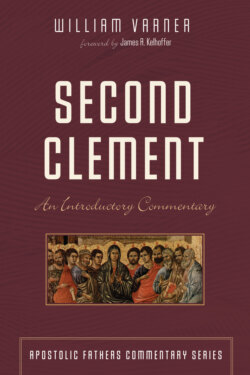Читать книгу Second Clement - William Varner - Страница 7
Foreword
ОглавлениеThe anonymous writing which came to be called the Second Letter of Clement may be that work of the Apostolic Fathers which you read decades ago in seminary or graduate school but subsequently forgot. The writing’s relative neglect in both earlier and recent scholarship is regrettable for several reasons. For one thing, 2 Clement may be the earliest work that cites and interprets sayings of Jesus that stem, either directly or indirectly, from the Gospels of Matthew and Luke. Additionally, its sometimes surprising interpretations and extensions of those sayings illustrate the creativity that often underlay early Christian biblical interpretation. Second Clement also contains several unusual sayings of Jesus, such as the quasi-androgynous prediction that, prior to the kingdom’s arrival, the “two” must become “one” and there will be “neither male nor female” (2 Clem. 12.2).
In addition to the import of the work’s sources, its message is significant since it represents a distinctive—and, in several respects, a unique—voice among the second-century Jesus movements which were competing for influence. One example of that distinctive message is the explanation of the first “person” (ἄνθρωπος) in Gen 1:27: the male is identified as Christ, rather than Adam, and the female is not Eve but the preexistent “church” (ἐκκλησία, 2 Clem. 14.2). Another noteworthy contention is that believers, by virtue of having received God’s grace, are obligated to render “repayment” (ἀντιμισθία, 2 Clem. 1.3, 5; 9.7; 15.2) to God in order to receive a “repayment” from God (11.6) and, ultimately, to withstand the final judgment and be saved. If we interpret a need for “repayment” in the light of the reciprocal giving and receiving which characterized ancient patron-client relationships, the obligation signaled by ἀντιμισθία would be an integral means of both fostering and preserving believers’ relationship with God (or Christ), their divine patron.
As historians and theologians, we make the most of the oftentimes anecdotal sources which happened to survive, pondering the light they could shed on the early church and its development. Given that 2 Clement cites several enigmatic sources, and that the work advocates for some possibly controversial theological positions, it is somewhat surprising that it is preserved in not one but three manuscripts. One reason for its preservation could be that it appears directly after 1 Clement in an early manuscript, Codex Alexandrinus (ca. 450–500 CE): although the two Clementine writings clearly stem from different authors (and, as many argue, address different communities), the notion that 2 Clement was somehow connected to a subapostolic leader (i.e., Clement of Rome) may have enhanced the work’s stature and secured its preservation. Additionally, the placement of 1 and 2 Clement in Codex Alexandrinus directly after the twenty-seven New Testament writings could have attributed to the Clementine writings a canonical status, leading some Christ-believers to transmit them and, quite possibly, to use them in liturgical and catechetical contexts.
Those who have devoted themselves to the study of 2 Clement belong to a modest, albeit by no means an exclusive, club and tend to engage in detail with one another’s views. This volume by William Varner is only the second English-language commentary on 2 Clement to appear since the 1960s, and invites us to take a closer look at a writing that all too often has been ignored or misunderstood. The strengths of Varner’s study include the lucid discussion of isagogical questions (e.g., the work’s genre, sources, and theological tendencies), which makes up around one-third of the volume; a fresh new translation; the attention to semantics; and the discussions of the work’s structure. The commentary will inform, intrigue, and even challenge not only its primary audience of evangelical Protestants but also those who stem from other religious and hermeneutical traditions. The volume will also spur others, myself included, to continue work on this fascinating text.
James A. Kelhoffer
Pentecost 2020
Uppsala, Sweden
